|
Opening
on a bright sunny day, we watch as a
small crowd gathered to witness the
dedication of a new suspension bridge
face an interminable delay as the
mayor and the chief of police of ... wherever the hell we are deal with
some massive feedback problems over the PA system. And, with the crowd
already restless, the ribbon
cutting ceremony is rudely interrupted
again when four men storm the bridge
and break through the assembled luminaries.
These men, the Faux Four -- better
known as The Monkees ... Micky Dolenz,
Peter Tork, Davy Jones and Michael
Nesmith -- appear to be fearfully running from
something. At the head of this
frightened pack,
Micky makes an abrupt right turn and
dives off the bridge, into the water
below, where the surrounding liquid
quickly transmogrifies, shifting and
swirling into amorphous blobs of
psychedelic colors. And then, while "The
Porpoise Song"
contemplatively serenades, several
mermaids join him and they swim
away...
Cut
to the Monkees' house, where a
beautiful girl passes from Micky, to
Peter, to Mike, and finally, Davy,
kissing them all as she goes. When
Mike wants to take the smooching a
little further, she just laughs him
off and leaves ... Cut to a wall of
television screens, showing life in
the late 1960's. And as our boys piss
and moan about being stereotyped by
their manufactured origins, and after
they promise to give the people what
they expect, all the screens shift to
the brutal assassination of a
Vietnamese POW -- except for the one
in the lower left corner, where a
woman is screaming; soon revealed to
be just a rabid fan of the group,
oblivious to the committed atrocities
all around her...
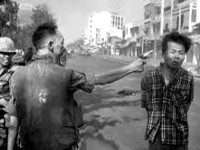
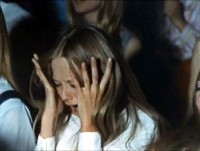
Cut
to a football field, where the boys
lead a raucous crowd in a cheer for
war, and then jump to a four-man
foxhole. Under heavy fire, Peter goes
for more ammo, pauses for a photo for LIFE
magazine, and runs afoul of a
mixed-metaphor in the form of a
football player (Green Bay
Packer legend Ray Nitschke), who
just wants to win the big game.
Getting by this lunatic, Peter makes
it back to the foxhole. Then,
together, Sgt. Nesmith and his Howling
Monkees storm into Ro-Man's cave,
fight their way in, only to emerge out
the other side in a concert arena,
where they tear through a rousing
rendition of "Circle Sky".
But as they play, mixed with shots of
the frenzied audience are clips of
terrified Vietnamese
refugees fleeing for their lives. To
punctuate the obvious to the
oblivious, when they
finish the song, the crowd rushes the
stage and tears the band apart...
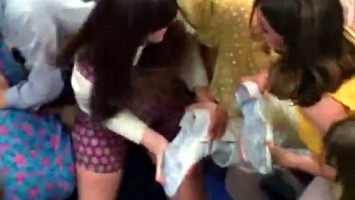
Okay,
letís get this outta the way first: I love the Monkees, and love 'em
almost unconditionally. Were they a
manufactured pop group? Absolutely.
Did they play their own instruments? I
donít care. But they didn't even
write the majority of their major
hits, you counter. Again. Don't care.
How many songs do you think Elvis
wrote for himself? And we all know how
I feel about Elvis, right? Right. Now,
my only real beef with the Pre-fab
Four is when they get a little too
whiny over their artistic merit, or a
perceived lack of street-cred,
musically speaking, trying to make the
whole Monkee phenomenon out to be more
than what it rightfully was. And I
have no intention of doing that, here,
either. For, what it rightfully
is/was/whatever is pretty damned
clever, funny, and catchy as all hell as
is, whether we're talking about
their music or the TV series, and it
doesn't need me or anyone else blowing
smoke and sunshine up anybody's wazoo
to prove it. And yet, sadly, it was the belief
in one's own hype that destined the
group, which had flashed so big, so
bright, and so fast in 1966, to just
as quickly fizzle out in only two
short years.
The
brainchild of Bob Rafelson and Bert
Schneider, who, inspired by The
Beatles recent hit, A
Hard Days Night, pitched a copy-cat
combo-franchise to their bosses at
Screen Gems, a subsidiary of Columbia
Pictures, known mostly for
distributing Hanna-Barbera cartoons
and re-introducing The Three Stooges
to a brand new generation of fans via
the boob-tube in the 1950's.
(The duo had met and formed a
partnership while working on the
studio's The Wackiest Ship in the
Army.) Originally, Rafelson
and Schneider wanted to plug The
Lovin' Spoonful into their proposed
series, but the band was already
under contract with another label. So
was The Dave Clark Five. Thus, en
lieu of any other legal
entanglements, the decision was made
to start a band from scratch. Thus, a
wide net was thrown out, whose catch
was eventually whittled down to an
apprentice jockey, a former child
actor, a refugee from the Greenwich
Village folk scene, and a guy whose
mom invented White-Out.
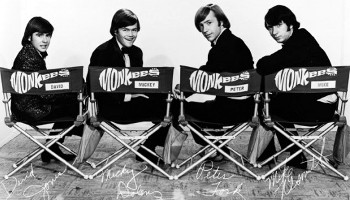
History
shows that these creators and
collaborators managed to catch
lightning in a bottle, everything
seemed to gel, and whether the show
was a vehicle to help promote record
sales or the records were released to
help boost the ratings is open for
debate. What isn't, was the popularity
of both. And while the series was
breaking ground and raking in Emmy
awards, the records, under the guiding
hand of Don Kirshner, with some
hideously infectious tunes penned by
Neil Diamond, Tommy Boyce and Bobby Hart,
the
Monkees were rocketing up the charts
and spinning gold records with each
new release. It was alchemy. Pure
alchemy. Alas, while things appeared
to be gelling on the surface,
underneath things were already
starting to curdle.
Soon
tiring of the same old formula and
fed-up with the restrictions of the
canned, "hands-off"
hit-making-machine, the four-headed
monster Rafelson, Schneider and
Kirshner had created was soon
rebelling. Wanting more input into
what went on onscreen, and, especially
after word broke that they weren't
playing their own instruments, just
adding vocals, the Monkees began to
exert more influence in the recording
studio, and, against their producers'
explicit wishes, began touring. Tork and
Nesmith were already established
musicians and Jones had a successful
musical theater run under his belt,
which may leave a person scratching
their head since Dolenz took lead
vocal on most of their hits. Also,
Dolenz had never played the drums in
his life. And though Jones was a
better drummer, initially being the
face of the franchise, the powers that be
forbade this because Jones was too
short and became obscured by the
drum-kit. And while the tours proved successful,
acrimony behind the scenes soon found
Kirshner getting himself fired,
leaving the Monkees to their own
recording devices. And while the music
might have been more creatively
satisfying, sales were quickly
leveling off.
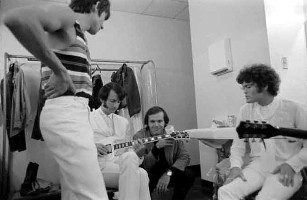
As
for the TV series, despite calls to
dump the comedy and transform it into
musical variety hour by the cast,
Screen Gems and NBC were content with
leaving things as is. However, it was
soon becoming apparent that the series
might be more trouble than it was
worth. Despite all this, the Monkees
still had enough juice for Rafelson
and Schneider to convince Columbia to
fund a feature film. And so, while the
second TV season floundered, as the
story goes, Rafelson, collaborator
Jack Nicholson, and the collective
Monkees met at a resort hotel in Ojai,
California, lit-up, licked-up, and
bounced ideas off each other and into
a tape recorder, which was roughly
translated into a shooting script.
Which is why HEAD can be best described as less of a film and more
of a stream of consciousness committed
to film, or random thoughts being
constantly bombarded by non-sequiturs,
bound together by metaphor that is, at
times, subtle and other times, not so
much. As for me, I think it can be
best described as some late-night
channel surfing, where you've already
cycled through the circuit several
times, stopping and randomly sticking
around long enough to see what a
program is before moving on, hoping
not for something better, just
something else.
Here,
though, Rafelson and his kooky quartet
have their hands on the remote
control. And as we bounce around from
Ronald Reagan giving speeches, Bela
Lugosi doing his thing in The Black
Cat, and some commercials for Ralph
Williams Ford Dealership, we finally
settle on another war film, with Micky
stumbling through the desert. Alone,
out of food and water, he finds a
stray Coke machine amongst the dunes.
But when he puts in his change, the
machine clunks empty. Flying into a
rage, Micky assaults the machine while
a Coke jingle merrily plays. Then, an
Arab horseman rides up, says "Pssssst"
in subtitles, and then rides away.
Next, a tank rumbles over a dune but
the driver quickly surrenders; and
then more soldiers appear, hundreds of
them, all laying their arms at
Mickyís feet before filing away.
After they're all gone, Micky crawls
into the tank, takes aim, and blows
the Coke machine to smithereens ...
When the smoke clears, we have another
musical interlude as our heroes find
themselves in a harem and indulge in
both the pleasures of the flesh and
the pipe....
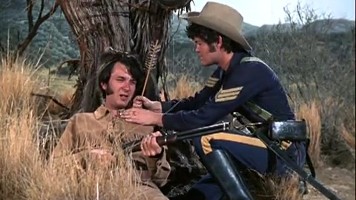
Change
the channel to the wild west, where a
wagon train is under Indian attack.
The situation dire, an injured woman
(Teri Garr) begs trooper Micky
to suck the poison out of her wounded
finger.
Nearby, Mike also lies gravely wounded
against a tree. As the Indians close
in for the kill, Mike tells Micky how
to remove the offending projectile; but Micky,
tired of
playing make believe, storms off
the set, breaking through the
backdrop, and disappears. Mike follows
him ... Change
the channel, and we find Davy in front
of a Brownstone, playing the violin.
But Mike and Micky, still in their
cowboy garb, interrupt his scene. Davy
follows them, and they wind up in a train yard,
where a Phantom Kook appears and
bellows at them for wandering off
the set.
(Timothy Carey -- who's made a career
out of playing phantom kooks.)
Leaving the Kook behind, the trio head down
a street, their mere
presence triggering a panic, as everyone else quickly
disappears. Inside a cafe, they find Peter
and a surly waitress, who chides
them as "Godís gift to the eight-year
olds." But Peter isn't
listening; intent on staring at --
nay, staring into his melting
ice cream cone as we change channels
again...
Now,
we settle on Davy, who's in a boxing
match with Sonny Liston -- and heís
losing badly. And as he's pummeled
senseless, our boy flashes back to his
violin playing, where he argues with
his girl (Annette Funicello) about
agreeing to be in this fixed fight.
But back in the ring, Davy refuses to take
a dive. In the crowd, when Mike criticizes
Micky for messing up the fixed fight, Micky loses it when
he's called a dummy and storms the ring. Mayhem
ensues until Peter magically appears
and reminds everyone that, no, he is the dummy,
and always the dummy, and then we jump back to
the cafe and the melting ice cream...
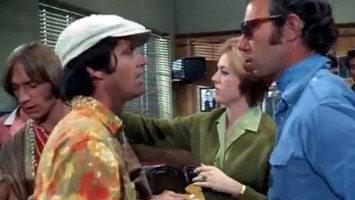
Here,
after
Peter decks the surly waitress, the
scene is a wrap and the director and
crew spill onto the set, including
Jack Nicholson and Dennis Hopper. Peter,
meanwhile, visibly upset, tries and
fails to corner the director (Rafelson),
the producer (Schneider),
anyone whoíll listen, really,
that
he isnít happy about having to hit a
girl. Suddenly, it starts snowing
inside the cafe, signaling another
musical interlude; which begins with
several serene scenes of nature that
quickly dissolve into chaos with the
intrusion of civilization, billboards,
power lines etc ... Change
the channels, again, and suddenly, we
find the boys in a factory. And while
the tour guide spends his nickel, Davy notices something isnít
quite kosher, here, but this realization comes
too late as the group is herded and
then locked
in a large darkened room -- to be known
from here on out as the Dreaded Black
Box. Floodlights soon blind them, and
the unseen director orders them to
come forward and crawl onto a giant
false head; seems they're supposed to be
dandruff for a shampoo commercial. And
so, they rummage around in the hair --
revealed to be the scalp of one Victor Mature.
__
__ __ __ __ __
__ __ __ __ __
__ __ __ __ __
__ __ __
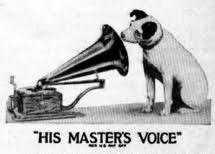 This
soon to be running gag of a giant
Victor Mature is a poke-in-the-eye at
RCA Victor, who distributed their
records, were in cahoots with the
brass at NBC,
and whose logo was a trained dog
transfixed by his master's voice. This
soon to be running gag of a giant
Victor Mature is a poke-in-the-eye at
RCA Victor, who distributed their
records, were in cahoots with the
brass at NBC,
and whose logo was a trained dog
transfixed by his master's voice.
__
__ __ __ __ __
__ __ __ __ __
__ __ __ __ __
__ __ __
Then,
a vacuum cleaner sucks the miniature
Monkees up. And while the rest wind up
in the bag, where they marvel at the
giant reefer butt found within, Davy
gets stuck in the nozzle. Managing to
crawl his way back out, we get another
dazzling musical interlude, where Davy
gets his Anthony Newly on something
fierce as he sings and dances with
Toni Basil. When the number ends, Davy
heads outside, where he bumps into
Frank Zappa and a talking Hereford
bull. Both are critical of Davy's
number, and Zappa advises Davy to
worry less about the dancing and more
about the music because the youth of
America are depending on him to show
them the way.
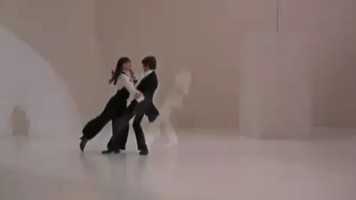
Suddenly,
the Dreaded Black Box emerges from out of
a nearby street and the other three Monkees
bail out. Accosted by a passing police officer
(Logan Ramsey), who, after
listening to
their story about the factory, the
dandruff, and the vacuum cleaner, is ready
to haul them all in on suspicion of drug
use, when Davy and a passing military
parade saves them ... Herded
into a restroom, Davy sees a large,
bloodshot eye in the mirror; but Peter
doesnít see it. When Davy looks again, he's suddenly zapped
into the House of Usher set --
complete with some sinister laughing. He
heads for a large red door, opens it,
and we spy a very large bug.
Only he isnít looking at it -- Micky
is, decked out in a safari gear, pith helmet and a
magnifying glass. And then Mickyís
captured by jungle savages and chained
to a wall next to Peter and Mike. But the
wall quickly revolves and they find themselves
in the bathroom where Davy saw the
giant eyeball. And after the same surly
policeman rousts them out of the john,
he looks in the mirror, sees Victor
Mature, and passes out...
Change
the channels, and we find Mike
in bed, who is rudely awakened
by a doorbell. Answering the call,
Peter receives a telegram, and, as he reads,
he inexplicably winds up on the House
of Usher set, too. Back in the
house, when he finally
wakes up, Mike finds everybody gone, and
then trips out as the film solarises while he slowly retreats back
into his bedroom, pursued by a bunch
of silver balloons. Turns out this was all
for a surprise party for Mike, who
isnít all that happy about this because all he
really wanted to
do was stay in bed. Then, the Phantom
Kook shows up again, compliments Mike
on his surly sentiment, rants some
more, and then appears to have a
stroke ... Change the channels, and we
find Mike and Davy in jail. Peter,
meanwhile, is in a steam-room with the
mystical guru, Abraham Sofaer, getting
some advice
on the cosmos and our place in it. When
Peter thinks he has
it all figured out, he seeks out the
others, finding Mike and Micky betting on
whether a distressed girl will jump off a
building or not. Peter tries to clue
them in on his big revelation, but
they won't listen. Moving on, he
tracks down Davy in that trippy
bathroom; but he won't listen, either.
When they all regroup, Peter tries
again, but his warning comes too late
as they all wind up back in the Dreaded
Black Box. Trapped inside, Peter
finally has a captive audience and
goes into his mystical spiel,
inspiring Davy to just kick the walls
down.
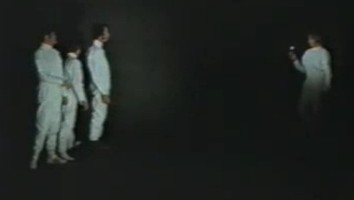
Free
again, the Monkees fight their way out of the factory and begin
revisiting earlier sets, where they
run into the Phantom Kook, who is
determined to rein them in permanently.
But our boys manage to dispose of him with a handy
cannon. Alas, the 50-foot Victor
Mature returns and scares them back inside the
Dreaded Black Box. The Box is then airlifted and
dropped into the desert, where it
breaks open on impact, revealing that
they're now surrounded by everyone
we've met so far -- the soldiers, the Arabs,
the Indians, all the women, Victor
Mature, and even the Coke machine! And
here, as the film kicks into a kind of
surreal-overdrive, the group is thrown
back into the factory, fight their way
back out, and wind up in a dune-buggy
... Peter floors it, and they're
magically back in the desert, with Big
Victor right on their tail. Big Vic
then kicks the car over, making the
Monkees flee for the lives on
foot.
Soon
pursued by everyone, the quartet head
for a bridge, where a dedication ceremony is taking place.
And as the mayor and the chief of police
fiddle with a troublesome microphone,
the Monkees plow through the
ribbon-cutting ceremony, and then, one
by one, jump off the bridge. Plunging deep
into the water below, the pretty colors
start to swirl, "The Porpoise
Song" kicks up again, and,
free at last, everything
seems nice and peaceful until our boys
realize they're trapped in an
aquarium -- an aquarium that looks
suspiciously like the Dreaded Black
Box.
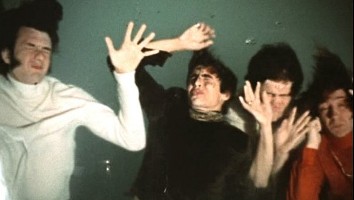
The
End
Man
... that is one strange film. And
awesome. Strangely awesome. I'll
admit, I don't get it. But I like it.
Well ... I sort of get it. And I like
it. No. Wait. I totally get it. And I
really, really like it. A lot. Now, while
some would argue that HEAD has
no plot, geez, I dunno, I just spent
the last couple hours pounding out
that synopsis. So, yeah, there is one;
it's just kinda hard to follow the
circular logic of it amidst the
thunder and the chaos as Rafelson and
company really blew up the toy-box in
their efforts to deconstruct the
phenomenon they had created.
Deconstruct it? Hell, they demolished
it and sewed the resultant wreckage
with salt and urine.
Yes,
the Monkees felt trapped by the
machinations of their success -- the Dreaded Black Box. And
whenever they tried to break out, to do
their own thing, or try
something different, they are met with
resistance on all fronts and are then
lured or forcefully
herded back into the Box. The film
also makes a stinging commentary on
commercialism, celebrity, and the
folly of war by holding a mirror up to their rabid
fan-base, who are so caught up in
Monkee-mania, what's being spoon fed
to them, they donít see the
horrors going on in the world
around them. Which is why one could
also argue that HEAD hedges dangerously
close to the precipice of pretentiousness.
[And some would argue it most
definitely did take that plunge with
an embarrassing belly-flop into the
very same pool.] But its
saving grace, I believe, is that this allegedly shallow,
manufactured pop group was completely sincere with
their message. But in their search for
deeper meaning, keeping it real, and
standing or striving for significance,
they tended to overlook the fact that
they did serve a purpose
already by making folks laugh, a lot,
offering an escape from those very
same horrors. I mean, Didn't Sullivan's
Travels teach us anything?
__
__ __ __ __ __
__ __ __ __ __
__ __ __ __ __
__ __ __
"Of
course HEAD is an utterly and
totally fragmented film. Among other
reasons for making it was that I
thought I would never get to make
another movie, so I might as well
make fifty to start out with and put
them all in the same feature."
--
Bob
Rafelson
__
__ __ __ __ __
__ __ __ __ __
__ __ __ __ __
__ __ __
Despite
this schizophrenic nature of this most
extraordinary adventure - western -
comedy - love story - mystery - drama
- musical - documentary - satire -
film ever filmed, Rafelson did a
commendable job of holding the film
together. Honestly, I think he did his
best work in the editing room, with
Mike Pozen and an uncredited Monte
Hellman, which
keeps this patchwork assault on the
senses moving forward -- the highlight
being Jones' "Daddy's
Song", where the director seamlessly
spliced together the different colored
takes into one helluva an eye-popping
show-stopper. In fact, the original
cut of the film was nearly two hours
long; but after a disastrous sneak
preview, the studio forced Rafelson to
go back and gut over a half-hour out
of it.
Even
before the cuts, while the film was
still in production, Screen Gems, NBC
and their cantankerous
cast had had enough of each other and pulled the plug on The
Monkees TV series after the second
season wrapped. And with no faith in
the film, and fearing that what they
felt was an incomprehensible mess
would only hurt record sales, the
initial advertising campaign for HEAD
neglected to mention the Monkees
at all. And then, two months after the
show got cancelled, HEAD was
quietly released in November of 1968,
where, after a lukewarm reception by
critics and ticket buyers, Columbia
left it to wither and die.
It
should be noted that Rafelson and Schneider
didn't put up much of fuss when the
Monkees' plug got pulled. The two had
always acted as a buffer between the
studio and their unruly stars, but
that came to an abrupt end when HEAD
got a green light. Remember that hotel
script-session I mentioned earlier?
Well, apparently, when Nesmith found
out that he and the others weren't
going to get a screenwriting credit,
those tapes mysteriously disappeared.
When that didn't work, Nesmith, Jones
and Dolenz went on strike, and only
Tork showed up for the first day of
filming. Again, the bluff backfired,
and, worse yet, the damage to their
creative partnership
could not be undone. Which goes a long
way in explaining why Rafelson and
Schneider so casually cut bait and
moved on to their next counter-culture
project, Easy Rider, leaving
the already fragmenting Monkees to
finish falling apart all on their own,
allowing them to finally break out of
the box and do their own thing --
mostly reunion tours.
|